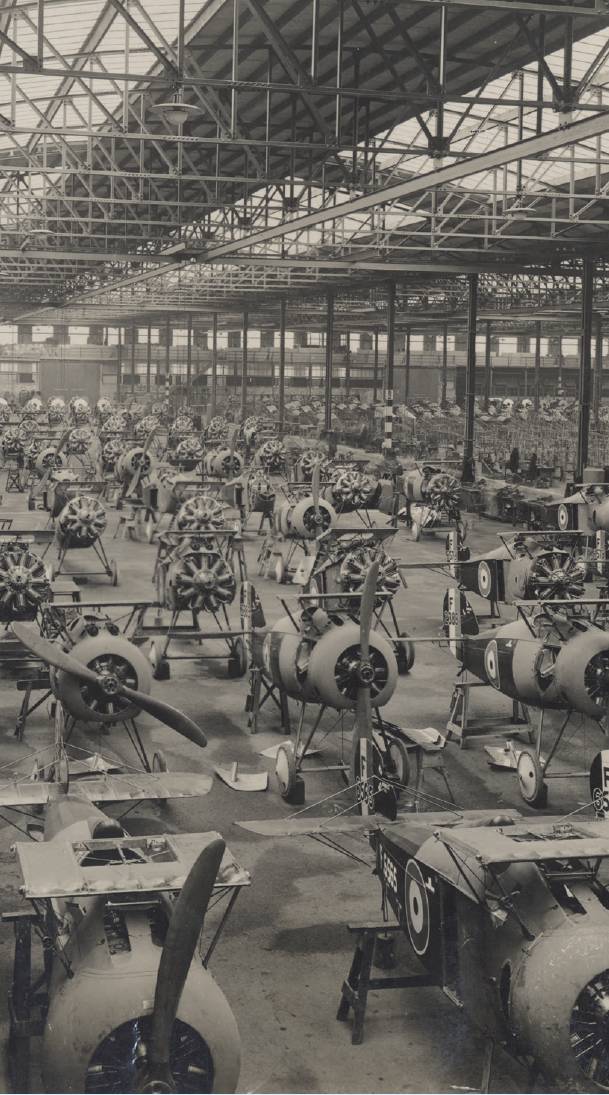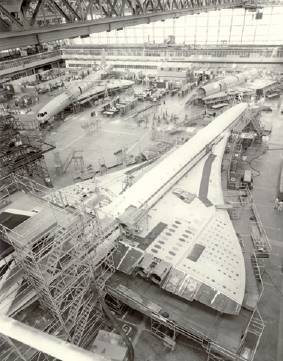Archive
Guide to the Archives of UK Aircraft Manufacturers just published
Whether you are looking to find an older research paper that supports a design decision or wish to explore the history of one of our great aircraft designs, the biggest challenge is to find where the original paperwork is stored and, in some cases, whether it survives. Such searches are not helped by the fact that over the years the documentary evidence of our aero history has been scattered among a large number of archives, libraries, museums, societies and individuals.
 Sopwith Snipe and Salamander fuselages in the Ham works, December 1918.
Sopwith Snipe and Salamander fuselages in the Ham works, December 1918.
To help the aero history community to find some of the amazing archive collections being preserved around the nation, the Aviation and Aerospace Archives Initiative (AAAI) has just launched a new online guide to the surviving historical records of UK aircraft manufacturing businesses. The guide covers not only household names such as the British Aircraft Corporation but also lesser-known concerns like the Airship Guarantee Co or firms such as Phoenix Dynamo Manufacturing Co which only built aircraft in wartime. Institutions, such as the Royal Aeronautical Society and Aeronautical Research Council which represented the collective interests of aircraft manufacturers and their employees or promoted aeronautical research, are also included.
The guide is alphabetically arranged by company name and includes a brief history of each aircraft manufacturer along with a chronological list of its most significant aircraft and a summary of the surviving archives reported to date. The guide covers airframe companies, including lighter-than-air and rotorcraft, as well as fixed-wing aircraft. We hope to include material produced by airline operators and other aviation manufacturers in future surveys.
 Concorde production in the main assembly hall at Filton. RAeS (NAL).The new archive guide can be found via the AAAI website: https://www.aviationarchives. uk. It currently features entries on the archives of over 90 companies and organisations and a useful guide to related sources held by The National Archives but is far from complete. Many holders of aircraft manufacturer archives are not yet included and the AAAI’s aim is to extend and improve the existing entries and to add new ones over the next year or so through a process of co-creation with custodians and users of aviation archives. So, if you care for, or are aware of, archives that should be covered and do not seem to appear in the first edition of the guide, please do get in touch with the AAAI. Information on how to contribute is available on the webpages accompanying the guide.
Concorde production in the main assembly hall at Filton. RAeS (NAL).The new archive guide can be found via the AAAI website: https://www.aviationarchives. uk. It currently features entries on the archives of over 90 companies and organisations and a useful guide to related sources held by The National Archives but is far from complete. Many holders of aircraft manufacturer archives are not yet included and the AAAI’s aim is to extend and improve the existing entries and to add new ones over the next year or so through a process of co-creation with custodians and users of aviation archives. So, if you care for, or are aware of, archives that should be covered and do not seem to appear in the first edition of the guide, please do get in touch with the AAAI. Information on how to contribute is available on the webpages accompanying the guide.
Alison Turton of the Business Archives Council has edited the guide and it has been supported by a number of collections across the country, including the Science Museum, Aerospace Bristol, the Jet Age Museum, Portsmouth City Archives and the Society’s National Aerospace Library. Thanks must also go to the members of Air-Britain who have been checking the guide and to Dr Ron Smith FRAeS who allowed the AAAI to use material from his series of books on aircraft firms across the country and who has produced a short history of the aviation industry designed to put the work of individual firms into context.
The survey is a core element of the work of the AAAI which was formed in late 2018 to support all those who look after archival records relating to the history of flight, and related industries and technologies, and to promote access to them. In 2020 the AAAI also published guidance to help those who care for archival material and links to that guidance can be found via the AAAI website: https://www.aviationarchives.uk, while news of its 2020 conference can be found in June 2020’s edition of AEROSPACE, pp 34-37.